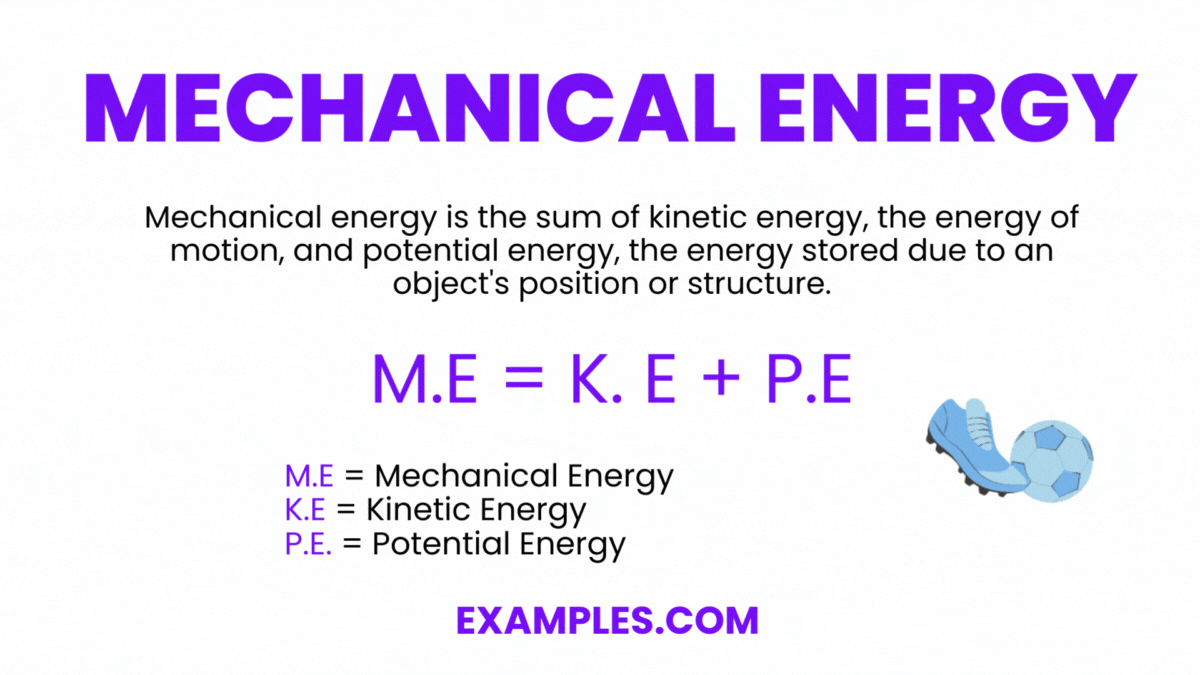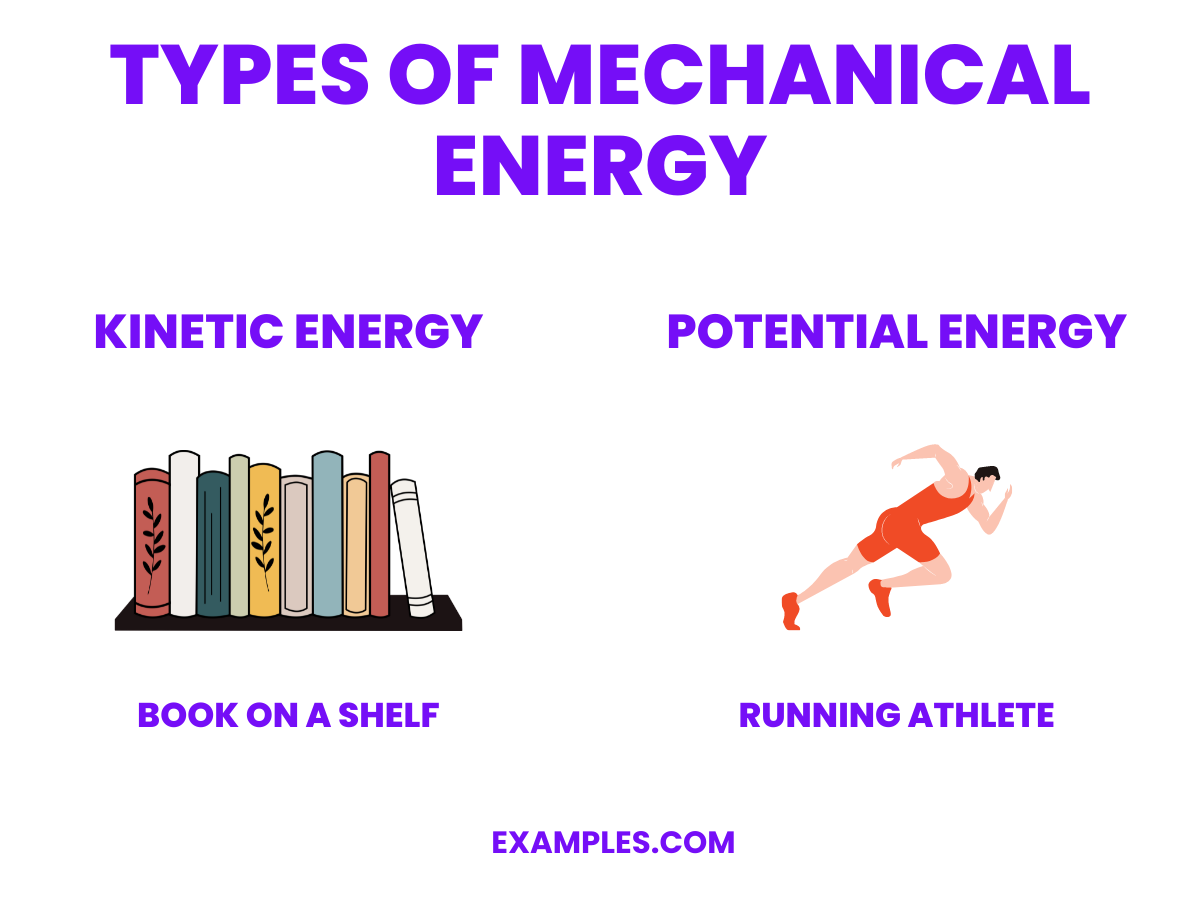Which of the following best describes mechanical energy?
The energy stored in chemical bonds
The energy associated with the motion and position of an object
The energy stored in atomic nuclei
The energy from electromagnetic waves


Mechanical energy, a cornerstone concept in physics, stands as a critical element in understanding the dynamics of motion and forces. It’s an amalgamation of kinetic and potential energies, seamlessly interplaying within objects in motion or at rest. This guide delves into the essence of mechanical energy, providing clear, comprehensible examples and definitions. Ideal for educators and learners alike, it breaks down complex physics into easily digestible information, fostering a deeper comprehension of this fundamental principle.
Mechanical energy is the sum of kinetic energy, the energy of motion, and potential energy, the energy stored due to an object’s position or structure. It’s a key concept in physics, illustrating how energy is conserved and transferred between objects and forms. This energy plays a pivotal role in everything from simple daily tasks to complex mechanical systems, making it an essential topic in physics education.
One of the best examples of mechanical energy in action is a roller coaster. As the coaster climbs to the top of a hill, it accumulates potential energy. This energy is due to its elevated position and the gravitational pull. Once the coaster begins its descent, this potential energy converts into kinetic energy, the energy of motion, propelling it along the tracks. This transformation and conservation of energy, from potential to kinetic and vice versa, perfectly illustrate the concept of mechanical energy in a tangible, relatable way.
Mechanical energy, a fundamental concept in physics, can be described as the sum of kinetic energy and potential energy. In simpler terms, it’s the energy associated with motion and position. The formula to calculate mechanical energy is:
M.E = K. E + P.E
{ Mechanical Energy = Kinetic Energy + Potential Energy }
K.E. = 1/2×m×v2
And
P.E. =m×g×h
Hence,
M.E. = 1/2×m×v2+m×g×h
| M.E. | Mechanical Energy |
| K.E. | Kinetic Energy |
| P.E. | Potential Energy |
| m | Mass of the object |
| g | Acceleration due to gravity |
| h | Height position |
| v | The velocity of the object |
Delve into the world of mechanical energy with these 22 unique and vivid examples, each illustrating the remarkable ways in which mechanical energy shapes our world. From everyday occurrences to sophisticated machinery, this collection showcases the versatility and omnipresence of mechanical energy. It serves as an excellent educational resource for teachers aiming to elucidate this fundamental physics concept to students. Through clear, concise explanations, these examples are tailored to enhance understanding and spark curiosity in the realm of physics.
The sources of mechanical energy are diverse and integral to various applications in daily life and industrial processes. They range from natural forces to engineered systems, each playing a crucial role in converting different forms of energy into mechanical energy.

Mechanical energy, pivotal in physics, is classified into two primary types: kinetic energy and Potential Energy. Kinetic Energy is the energy of motion, evident in moving objects, while potential energy is stored energy, present due to an object’s position or structure. This distinction is crucial for understanding various physical phenomena and energy transformations. Here, we explore examples demonstrating each type, offering a practical understanding of these fundamental energy forms.
Kinetic energy is a captivating concept in physics, illustrating energy in motion. It’s essential for teachers and students to grasp this idea through real-world examples. Our list provides a diverse range of instances where kinetic energy is at play, making the concept tangible and easier to understand.
Discover the hidden mechanics of everyday life with these mechanical energy examples. From household chores to recreational activities, mechanical energy is omnipresent, subtly powering our daily routines. This exploration offers insight into the practical application of physics principles, making the abstract concept of mechanical energy tangible and relatable. It’s an invaluable resource for teachers and students, simplifying complex ideas into everyday occurrences.
Engaging and educational, these mechanical energy examples are perfect for young minds. Each example is a playful yet informative demonstration of mechanical energy in action, encouraging kids to observe and understand the physics in their surroundings. This section is crafted to spark curiosity and foster a love for learning among children.
Mechanical energy seamlessly integrates into our daily lives, often unnoticed. This section unveils its presence in routine activities, demonstrating how fundamental physics principles are to our everyday experiences. These examples are carefully chosen to resonate with both teachers and students, simplifying the concept of mechanical energy.
Converting mechanical energy to electrical energy is a process central to many modern technologies. This conversion typically involves using mechanical force to turn a generator, which then produces electricity. This principle underpins much of our power generation infrastructure, from wind turbines to hydroelectric dams.
Producing power from mechanical energy involves a series of steps, each crucial to the transformation of energy from one form to another. This process is fundamental in power generation and mechanical systems.
Mechanical energy follows a very simple formula of (M.E.) = ((1/2)mv^2) + (m × g × h). Where M.E. is mechanical energy (J), m is the mass of the object (kg), v is the velocity of the object (ms^-1), g is the acceleration due to gravity (constant 9.81 m/s^2), and h is the height of the object (m).
Begin by writing down the formula for mechanical energy, so that you have a visual outline of the final form of the equation. The formula should be (M.E.) = ((1/2)mv^2) + (m × g × h).
After you have written the formula for mechanical energy, you will need to list down all the variables given in the problem. Doing this will help you reduce instances of confusion when substituting the values. Not only that but you have to ensure each variable has the correct applicable measurement. If any of the variables are the wrong measurement, convert them accordingly.
You must substitute each variable to the correct value in the mechanical energy equation. After doing that, you will be presented with a missing variable which the equation will try to answer.
When you have solved the equation, you must ensure that the value you answered is the correct measurement value. If the variable you have obtained from the mechanical energy equation is not the asked measurement, convert it accordingly.
People have defined kinetic energy as the energy exerted by an object in motion, which is the juxtaposition of potential energy. An object exerts kinetic energy through actions that involve work and movement. Mechanical energy, on the other hand, is the overarching energy that kinetic and potential are categorized into. This energy refers to both the potential energy and possible kinetic energy a single object can create and manipulate. Mechanical energy is the system that takes into account the potential energy of an object in place and the kinetic energy of an object put to work. In conclusion, kinetic energy deals with a specific part of work, whilst mechanical energy takes into account the whole system.
Following Newton’s third law of motion, wherein Newton states that every object has an equal and opposite reaction, the object exerted upon will move or stay still depending on the exerted mechanical force and energy. This means that an object at work will either push or pull an object of lesser resistance to the direction the moving object is directed at. If the inertia is stronger than the force of the working object, then said object will not move or displace the other object it has impacted.
Mechanical energy is one of the most important and abundant forms of energy that one can easily observe in nature. This makes it very easy for people to utilize and harvest electrical energy through the usage of specialized tools and instruments. The reason why people can do this is because of the law of conservation of energy, which states that energy can never be created nor destroyed, only converted from one form to another. Using this principle, humans have been able to convert mechanical energy into electrical energy through the use of hydropower plants and wind turbines.
Mechanical energy is a type of energy that deals with the motion of an object through the concept of work. This type of energy is very abundant and can be converted into heat or electrical energy, which is used in both exercise and electrical generation. Therefore, it is very important to understand the concept of mechanical energy, even a simple grasp of this concept allows one to know how this energy works and affects our everyday lives.
Text prompt
Add Tone
Mechanical Energy Formula
22 Mechanical Energy Examples
Which of the following best describes mechanical energy?
The energy stored in chemical bonds
The energy associated with the motion and position of an object
The energy stored in atomic nuclei
The energy from electromagnetic waves
What is the kinetic energy of a 2 kg object moving at a speed of 3 m/s?
3 J
6 J
9 J
18 J
Which of the following is NOT a type of potential energy?
Gravitational potential energy
Elastic potential energy
Chemical potential energy
Thermal potential energy
An object is moving with a constant speed in a circular path. Which type of energy remains constant?
Kinetic energy
Potential energy
Total mechanical energy
Both A and C
Which of the following is an example of converting potential energy into kinetic energy?
A car accelerating on a flat road
A ball rolling up a hill
A rock falling off a cliff
A person sitting still
The work done on an object is equal to which of the following?
The change in its potential energy
The change in its kinetic energy
The change in its mechanical energy
All of the above
A pendulum has maximum potential energy at which point in its swing?
At the lowest point
At the highest point
At the midpoint
At the equilibrium point
What happens to the kinetic energy of a moving object if its mass is doubled while its velocity remains constant?
It remains the same
It is halved
It is doubled
It is quadrupled
A 0.5 kg ball is thrown vertically upwards with an initial velocity of 10 m/s. What is its kinetic energy at the moment of release?
5 J
25 J
50 J
100 J
What is the relationship between work and mechanical energy?
Work is equal to the change in mechanical energy
Work is the potential energy of an object
Work is always greater than mechanical energy
Work is unrelated to mechanical energy
Before you leave, take our quick quiz to enhance your learning!

